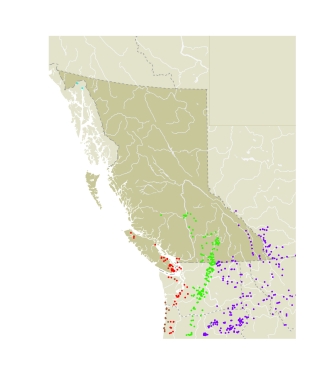AdultThe Zerene Fritillary is the most variable of BC fritillary species, and thus the hardest to characterize. Wherever it occurs in BC, it is larger than any of the species still to be discussed. On the ventral hindwing, the basal and median area is a chocolate brown colour that varies in intensity between subspecies. Comparing specimens with the photographs provided is the best way to determine the species.
Immature StagesThe mature larva is black. The body is covered with protuberances that bear spines. The bases of the spines are black on the first two rows dorsally and yellow on the third and fourth rows (Hardy 1958a). There are two mid-dorsal narrow yellow stripes. Speyeria zerene and S. callippe are identical in the larval stages. The egg is 1.0 mm x 0.60 mm and dull cream (Hardy 1958a).
SubspeciesThe Vancouver Island and Gulf Islands populations are Bremner's Fritillary, S.z. bremnerii (W.H. Edwards, 1872) (TL: San Juan Is., WA), which occurs south in the Puget Trough and the Willamette Valley to near Corvallis, OR. This is the darkest of the described subspecies. The Alaska panhandle subspecies (a new subspecies) is smaller and somewhat paler; it is expected that S.z. sitka will eventually be found in BC. The Painted Fritillary, S.z. picta (McDunnough, 1924) (TL: Aspen Grove, BC), is restricted to the eastern slope of the Cascades and the southern Cariboo. It is smaller than either bremnerii or garretti. The Washington butterfly atlas (Hinchliff 1996) does not distinguish the Painted Fritillary from the much more widespread Garrett's Fritillary, S.z. garretti (Gunder, 1932) (TL: Cranbrook, BC), which occurs from the Okanagan Valley east to the Rocky Mountain Trench. Garrett's Fritillary occurs south to northeastern Oregon and northwestern Wyoming. It is the largest subspecies and has the lightest ground colour in the basal and median areas of the ventral hindwings. In Washington this species is often confused with the Coronis Fritillary, S. coronis, which has not yet been recorded in BC.
Speyeria zerene sitka P.C. Hammond, J.L. Harry & D.V. McCorkle, new subspecies. Male: Forewing length (n = 9) 23-26 mm (average 25 mm). Dorsal wing surface medium orange to yellow orange with black spots and bars, heavy dark basal suffusion present, and veins of forewing thickly covered with dark scales. Ventral forewing with yellow orange ground colour, brown patches around the silver postmedian spots of the subapical area. Ventral hindwing with a red-brown disc covered with some yellow suffusion, and with a wide yellow submarginal band. Spots brightly silvered and narrowly outlined basally with black scales. Median spots small and round, submarginal spots also small and rounded to flattened. Marginal border red brown like disc. Female: Forewing length (n = 4) 25-28 mm. Similar to the male, but veins of forewing not thickly covered with dark scales. Ventral forewing with red orange ground colour.
Grey and Moeck (1962) associated this disjunct Alaskan subspecies with S.z. hippolyta (W. H. Edwards, 1879) (TL: Oceanside, Tillamock Co., OR) of the OR and WA coast because of the small wing size of the two subspecies. However, S.z. hippolyta usually has a much darker, reddish brown disc and a narrow yellow submarginal band on the ventral hindwing. Between these two subspecies, a third subspecies, S.z. bremnerii, is found from Oregon east of the coast and north to the north end of Vancouver Island. S.z. bremnerii is much larger, with male forewing length 27-33 mm and female forewing length 30-36 mm. A few specimens of S.z. bremnerii from western Washington have the bright red-brown disc and wide yellow submarginal band of S.z. sitka. Thus, it is plausible that S.z. sitka is derived from S.z. bremnerii.
Types. Holotype: male, AK, Haines, 11 August 1949, G.E. Pollard. The holotype is deposited in the California Academy of Sciences, San Francisco, CA, USA. Allotype: female, same data. Paratypes: 1 male and 3 females, same data (CAS); 1 male, AK, Mile 18 Haines Hwy., 7 July 1972, J.L. Harry (JLH); 4 males, AK, Haines, 2.1 miles SW at Mile 26 Haines Hwy., 23 July 1999, J.L. Harry (JLH); 2 males, same locality, 31 July 1999 (JLH).
